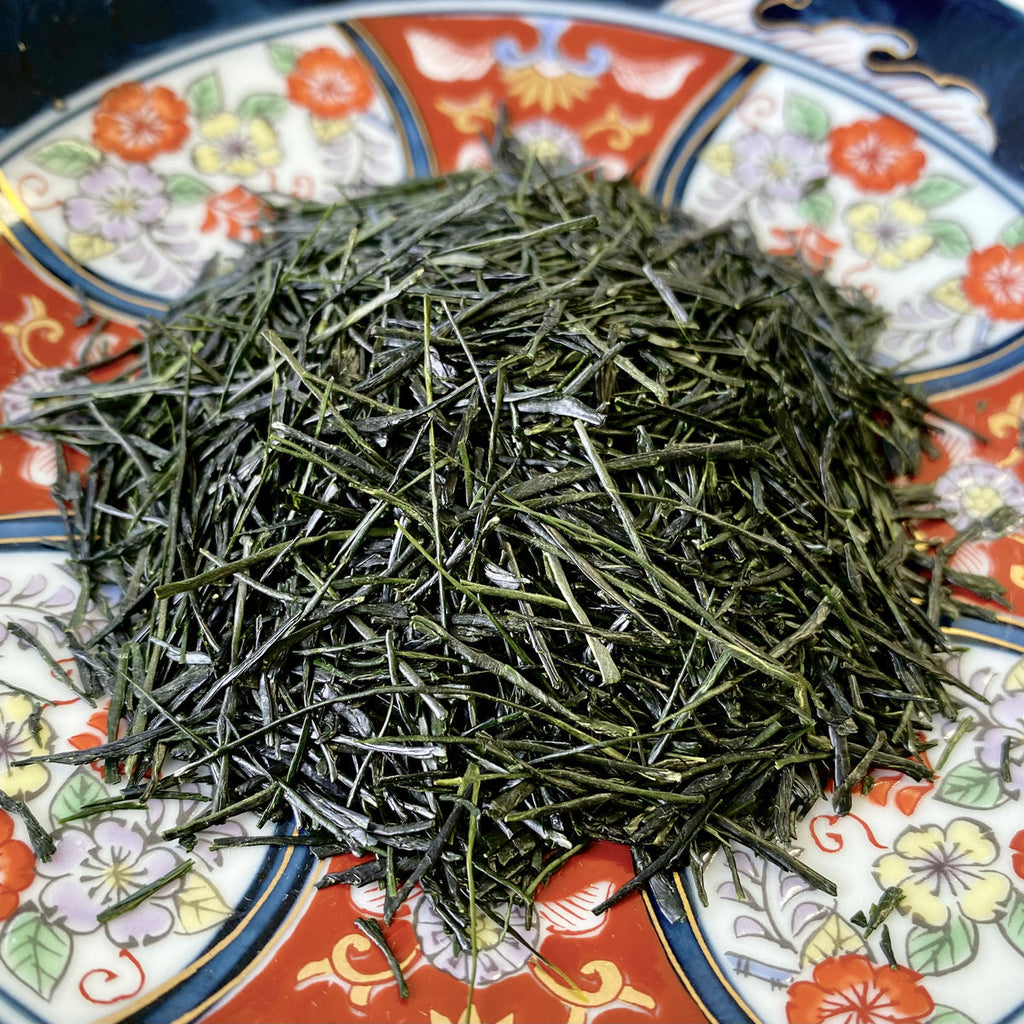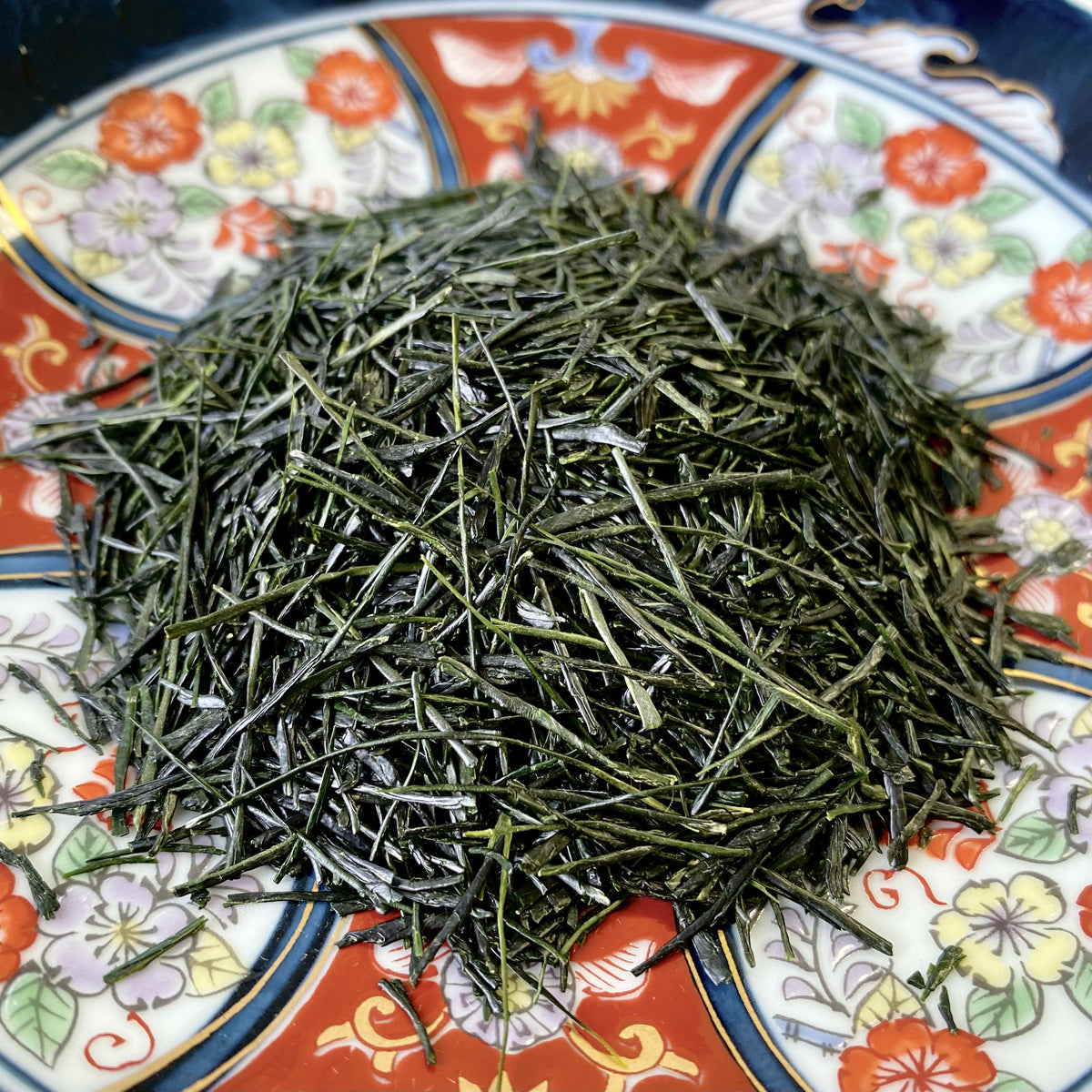故郷(日本)からのお茶のニュースを少しご紹介します。
先月22日から25日にかけて、第77回全国茶会(福岡実行委員会主催)が開催され、全国茶品評会の結果が発表されました。全国茶品評会は1946年から続くもので、全国の茶業関係者が一丸となって茶の生産技術の向上と消費拡大を目指しています。また、日本茶経営の更なる発展も目指しています。
今年の茶祭りは、南日本有数の茶産地である福岡県八女市で開催されました。今年は八女茶誕生600周年という節目の年にあたることもあり、八女市にとって特別なイベントとなりました。八女市でこのイベントが開催されたのは、2005年以来18年ぶりです。さらに、八女市の茶農家である倉住勉氏が玉露部門で農林水産大臣賞を受賞し、八女市は同部門の産地賞を総なめにしました(当然のことですが!)。
最高賞の農林水産大臣賞と、特定の茶種で優れた成績を収めた市町村に贈られる産地賞は、8つの部門で選出されました。品評会の対象となる8つの部門は、普通煎茶(10kg)、普通煎茶(4kg)、深蒸し煎茶、かぶせ茶、玉露、碾茶、蒸し玉緑茶、釜炒り茶です。品評会は、福岡県で開催された品評会のメインイベントで、今年は17都道府県(日本は47都道府県)から合計832点の出品がありました。
お茶の分類についてですが、なぜ煎茶に重さの異なる2つの分類があるのかと疑問に思うかもしれません。これは、10kgの煎茶分類は機械で収穫されたお茶のみを対象としているためです(*ちなみに、鹿児島県産の煎茶はこの分類で上位にランクインし、静岡県産の煎茶はより重量の少ない4kgの分類で上位にランクインしています)。

お茶の審査方法
このコンテストはどのように行われるのでしょうか? Yunomiの創設者であるイアン・チュン氏が以前、 全国大会におけるお茶の評価方法について記事を書いているので、ここでは基本的な手順をいくつか概説します。
4kgの煎茶部門を除き、お茶は10kg単位で提出されます。これはコンテストに出品する品質のお茶です。つまり、茶農家はコンテストに出品するという強い思いを抱き、この特別なお茶の栽培と収穫に特別な手間と努力を費やしているということです。提出されたお茶はすべて、(1) 外観、(2) 香り、(3) 液色(つまり、淹れた後のお茶の色)、(4) 味の4つの基準に基づいて審査され、合計200点満点となります。満点は200点で、配点はお茶の種類によって若干異なります。


上:お茶の種類に応じた200点の配点を示した表とレーダーチャート。レーダーチャートは視覚的な楽しみを優先したものです。煎茶、玉緑茶、釜炒り茶は配点が同じなので、すべて同じ色で表しています。評価において、碾茶は淹れた葉の色という要素も加わります。
茶葉の外観を審査するために、茶葉は黒いトレーの上に置かれ、形状が検査されます。一般的に、外観で高い評価を得るには、茶葉の形状が非常に均一で、清潔で、光沢があることが求められます。審査対象となる茶葉は、並べて展示されます。
次に、審査員は残りの3つのお茶の内部特性を評価します。お茶の香りを判断するために、お茶(3gを計量して使用)は白いティーカップに淹れられ、淹れたお茶の色がはっきりと見えるようにします。次にお茶の液体の色を判断します。お茶の香りを審査したのと同様に、茶葉を計量して白いティーカップに入れます。3分間蒸らした後(浸出時間はお茶のカテゴリーによって異なります)、お茶の色を評価します。濁っていない透明な緑色は高品質と見なされます。最後に、審査員は最終的な基準であるお茶の味(文字通り翻訳されると、栄養)に移ります。全体的に、お茶の味が非常に重視されます。再びお茶は白いカップに淹れられます。ただし、今回はお茶を味見して評価します。審査員には個人的な好みがありますが、一般的に、お茶は旨味が豊富であるとみなされます。
第77回全国茶品評会 八女大会 結果発表
お茶がどのように評価されるかがわかったところで、詳細情報のほとんどは日本語でしか入手できないため、結果のいくつかを報告します。
玉露カテゴリー
今年の品評会は八女で開催されたので、まずは玉露部門から始めたいと思います。簡単におさらいすると、玉露とは日陰で栽培された高級日本茶のことです。玉露の最大の特徴は、豊かな旨味と豊かな風味です。煎茶は通常、日陰を作らずに直射日光の下で栽培されますが、玉露は意図的に日陰を作ります。日陰にしておく期間は平均約20日間ですが、地域、テロワール、茶農家のスタイルや好みなどによって期間は異なります。
今年の玉露品評会には、福岡、京都、鹿児島、静岡、埼玉、奈良の7府県から117点の応募がありました。先ほど、八女産が玉露部門で優勝したのは当然のことだと述べました。これは、八女産が日本茶市場の玉露の50%以上を生産しているからです。さらに、八女産の優位性と存在感は、近年の茶品評会での実績にも表れています。八女玉露は、全国茶品評会で連続して最優秀産地賞を受賞しています。八女の茶農家は玉露部門で連勝を続けていますが、京都府の茶農家が優勝をさらうこともあります。
今年の結果はどうだったでしょうか? 上位にランクインした玉露(最高得点を獲得した35種類の玉露)を見てみると、なんと1種類を除いてすべて福岡県八女市産です! 18位にランクインした玉露は、末吉茶房がある鹿児島県曽於市の茶農家のものです。 八女市産の高評価玉露が圧倒的に多かったことは、この地域の玉露の強みを改めて証明しています。私は玉露以外にも八女産の素晴らしいお茶をいくつか試飲しましたが、茶農家の方々は最高の玉露を作るために本当に努力されているのですね。
今年、最高得点を獲得したのは、茶農家の倉住勉氏の玉露で、200点満点を獲得しました。中でも、 栗原製茶の玉露が17位にランクインしたことは特筆に値します。栗原さん、心よりお祝い申し上げます。玉露の主要品種についてですが、上位35品種のほとんどが「さえみどり」で、茶品種の中でも注目の「 きらり」は3品種、「さえあかり」は1品種でした。
 栗原章宏さんの今年(2023年)のコンクールに出品された玉露がYunomiで販売中です。
栗原章宏さんの今年(2023年)のコンクールに出品された玉露がYunomiで販売中です。
煎茶部門(10kg&4kg)
10kg煎茶部門には7都道府県から104点の出品があり、4kg煎茶部門には14都道府県から110点の出品がありました。結果を一目見ただけで、10kg部門と4kg部門の両方で「やぶきた」が圧倒的な強さを見せていたことが興味深いと思いました。やぶきたが日本で長年スタンダード品種であったことを考えると、これは当然のことかもしれません。
10kg級煎茶の部では、鹿児島県南九州市(知覧地域代表)が産地賞を受賞しました。4kg級では、静岡県川根本町が地域賞を受賞しました。また、この部門で特筆すべきは、10kg級で今年3位に輝いた宮原光製茶の宮原健さんです。宮原さんは昨年も煎茶で2位を獲得するなど、常に上位にランクインするお茶を世に送り出しています。
 宮原健さんの全国茶芸コンクール2022 準優勝 やぶきた煎茶マイクロバッチ。写真からも、丁寧に揉み込まれた茶葉の繊細で上品な風合いが伝わってきます。
宮原健さんの全国茶芸コンクール2022 準優勝 やぶきた煎茶マイクロバッチ。写真からも、丁寧に揉み込まれた茶葉の繊細で上品な風合いが伝わってきます。
深蒸し煎茶
深蒸しとは日本語で「深く蒸す」という意味で、深蒸し煎茶は煎茶とは全く異なる点があります。茶葉を60秒以上(通常の煎茶は30~40秒)蒸すため、茶葉は非常に柔らかくなり、揉む際に崩れやすくなります。
静岡県や鹿児島県など5県から102点の応募がありました。この部門で上位にランクインした深蒸し煎茶は、すべて静岡県産でした。静岡県、特に牧之原市と菊川市の優位性は、歴史を振り返ることでより深く理解できます。茶葉を蒸す製法は、約250年前(1768年) 、 京都の永谷宗円によって発明されました。しかし、深蒸し茶のルーツは、実は静岡県、特に牧之原台地にあります。歴史の詳細についてはここでは触れませんが、興味のある方には興味深い話でしょう。通常の煎茶部門と同様に、深蒸し煎茶の高得点はすべてやぶきた品種でした。
かぶせ茶
かぶせ茶とは、軽く日陰をかけたお茶のこと。煎茶(日陰なし)と玉露(日陰が濃い)の中間のようなお茶と言えるでしょう。この部門には、福岡県、京都府、三重県、愛知県、奈良県、静岡県、鹿児島県の7府県から105点の応募がありました。結果を詳しく見てみると、上位32点のかぶせ茶は、最も多様性に富んだ部門だったと言えるでしょう。最高品質のかぶせ茶の多くは京都府産(特に舞鶴市と綾部市)でしたが、その他は福岡県(八女市と筑後市)、鹿児島県(霧島市、曽於市)、愛知県(豊田市)などでした。また、やぶきた品種が圧倒的に多かったものの、「さえみどり」や「きらり31」といった品種も加わり、多様性に富んだ作品となりました。
碾茶
 碾茶部門で最高位を獲得した「あさひ」。豊かな香りと上品な味わいが特徴です。築地茶園の茶畑、碾茶、抹茶の風景。
碾茶部門で最高位を獲得した「あさひ」。豊かな香りと上品な味わいが特徴です。築地茶園の茶畑、碾茶、抹茶の風景。
全国茶品評会には抹茶の部門はありませんが、抹茶の起源である碾茶は審査対象となります。碾茶とは、緑茶の葉を薄片状にしたもの(上図右上に描かれています)です。一般的に、碾茶の葉は約4週間日陰で蒸した後、揉まずに乾燥させます。その後、葉の茎と葉脈を取り除くことで、さらに精製されます。その後、より均一に粉末にするために、葉は細かく刻まれます。
てん茶部門には7府県から111点の応募があり、京都府と愛知県はてん茶/抹茶で有名な地域です。上位33点のてん茶のうち、大多数は京都府産(ほとんどが宇治産)で、福岡県八女市産はわずかでした。つまり、京都がてん茶の王者として際立っているようです!てん茶を作るために使用された栽培品種の多くは、アサヒと宇治ひかりの品種です。また、さえみどり、キラリ31、ナリノの品種のてん茶もありました。第3位のてん茶は、京都、西日本(関西)、そして全国レベルでさまざまなレベルで数々の賞を受賞した、世界的に有名な茶農家、 築地茶園の辻清治氏のてん茶でした。
蒸し玉緑茶・釜炒り茶
最後に、蒸した玉緑茶と釜炒り茶 茶葉の種類は様々です。海外では、これらの茶葉の種類はあまり知られておらず、他の日本茶とひとまとめにされている場合もあります。しかし、お茶通にとっては、明確な違いがあります。玉緑茶(別名:ぐり茶、縮れ茶)は、揉み工程を省略することで独特の丸みを帯びた形状をしています。そのため、一般的な煎茶のようにまっすぐな茶葉ではなく、縮れた形状をしています。玉緑茶は一般的に蒸して作られますが(釜炒りする場合もあります)、釜炒り茶は釜炒り茶のみを指します。
茶品評会の結果に戻りましょう!やぶきた品種は、上位にランクインした多くのお茶に使用され、その堅牢性を改めて証明しました。これらのカテゴリーで異なるのは、歴史的に優れた生産地が日本最南端の島、九州にあることです。
蒸し玉緑茶部門には、佐賀県、長崎県、熊本県、宮崎県の4県から101点の応募がありました。釜炒り茶部門には、佐賀県、熊本県、宮崎県の3県から82点の応募がありました。そして、両茶の最優秀生産者賞は、以前にも触れたお茶の産地、佐賀県嬉野市が受賞しました。2種類のお茶でダブル受賞は、嬉野市にとって大変喜ばしいニュースです。しかも、これらのお茶で最高評価である農林水産大臣賞を授与されたのも、嬉野市の茶農家でした。やったー!
まとめ
本日のブログ記事では、特定の茶生産地域の特徴に焦点を当てます。また、特に茶のカテゴリーにおいて、日本における特定の茶品種の優位性についても考察します。このブログ記事が、皆様にとって様々な日本茶への理解を深める一助となれば幸いです。
私は普段、煎茶や釜炒り茶を日常的に飲むことに安らぎと安心感を覚えるお茶好きで、玉露やかぶせ茶にはあまり手を出さないのですが、このレポートを書いているうちに、特に八女産の旨味たっぷりの玉露が飲みたくなりました!美味しいお茶はいつだって楽しみです…。ところで、今後のイベントといえば、 10月28日に八女市で第77回全国茶品評会の表彰式が開催されます。つい最近、 9月21日に八女県筑後市で出品茶の入札・即売会が開催されました。
関連記事:


